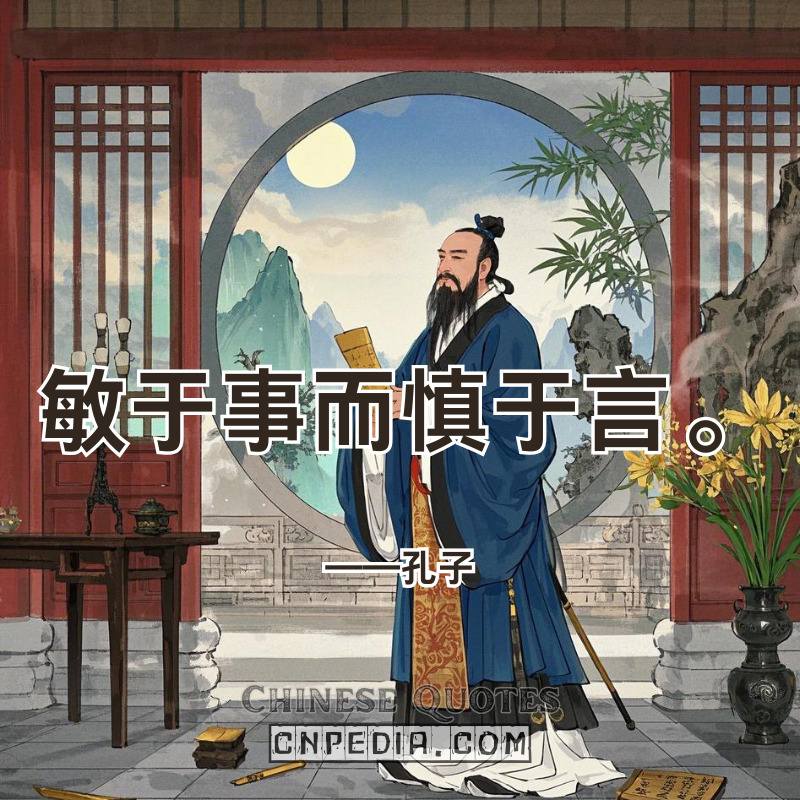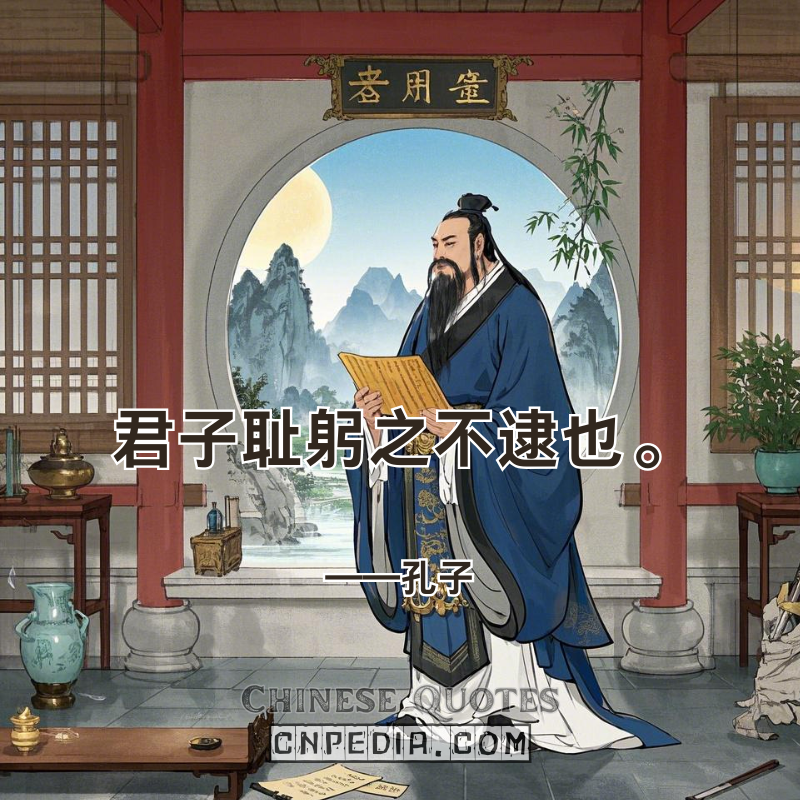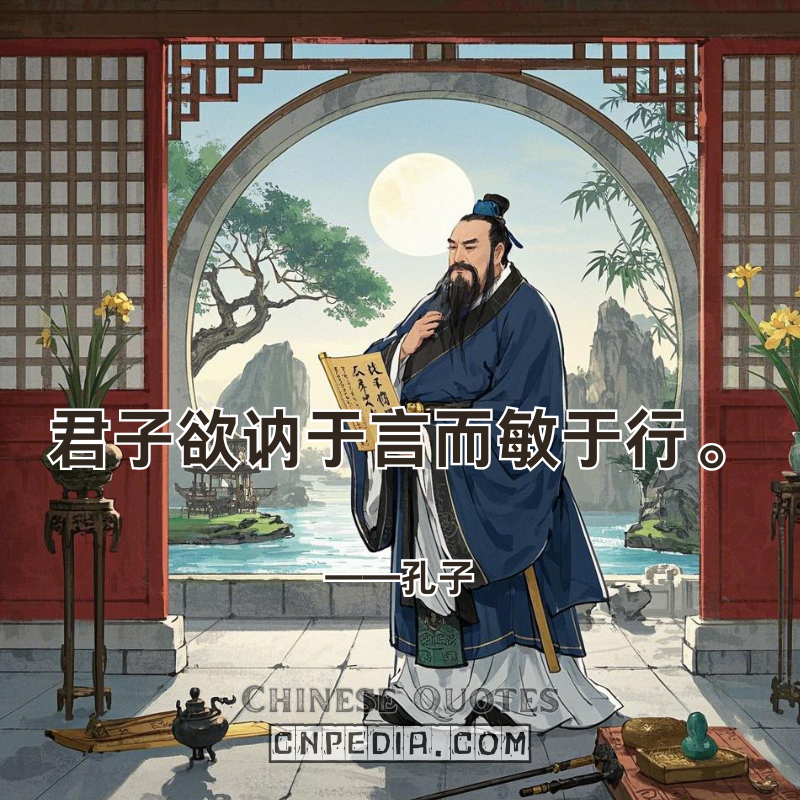Chinese Quotes Page 28

君子义以为质,礼以行之,孙以出之,信以成之。——孔子(jūn zǐ yì yǐ wéi zhì, lǐ yǐ xíng zhī, sūn yǐ chū zhī, xìn yǐ chéng zhī — Kǒngzǐ) Translation: “Nobles take righteousness as essence, ritual as path, humility as expression, trust as completion.”Explanation: Confucius’ statement outlines a four-stage ethical framework that intriguingly parallels modern systematic workflows. Firstly, “righteousness as essence” establishes moral clarity as the foundational blueprint, akin to lean manufacturing’s value-stream mapping where purpose precedes action. This prioritization of ethical intentionality ensures decisions align with core virtues before execution. Secondly, “ritual as path” systematizes implementation through standardized norms, mirroring lean principles of error-proofed processes. Just as manufacturing relies on repeatable protocols to minimize waste, Confucian rituals convert abstract ideals into actionable social behaviors, creating cultural consistency. Thirdly,...

君子博学于文,约之以礼。——孔子(jūn zǐ bó xué yú wén, yuē zhī yǐ lǐ — Kǒngzǐ) Translation: “Nobles cultivate broad learning, bound by ritual refinement.”Explanation: Confucius’ knowledge containment principle “君子博学于文(jūn zǐ bó xué yú wén), 约之以礼(yuē zhī yǐ lǐ)” (Nobles cultivate broad learning, bound by ritual refinement) establishes humanity’s earliest framework for ethical knowledge management. The character 约(yuē)—combining 糸(mì, silk thread) and 勺(sháo, ladle)—metaphorizes structured curation: like weaving disparate threads into patterned brocade, wisdom requires both expansive gathering (博学(bó xué)) and disciplined organization (约礼(yuē lǐ)). This philosophy shaped 汉朝石渠阁(hàn cháo shí qú gé) (Han Stone Canal Academy), where scholars copied texts onto 30kg bamboo bundles (博学(bó xué)), then bound them with silk ribbons (约(yuē)) coded by ethical categories—military strategies required red bindings only removable...

敏于事而慎于言。——孔子(mǐn yú shì ér shèn yú yán — Kǒngzǐ) Translation: “Be swift in action, guarded in speech.” Explanation: Confucius’ kinetic wisdom principle “敏于事而慎于言(mǐn yú shì ér shèn yú yán)” (Be swift in action, guarded in speech) establishes humanity’s earliest framework for calibrated responsiveness. The character 敏(mǐn)—combining 攵(pū, rapid action) and 每(měi, meticulous repetition)—encodes comprehensive adaptability: like a seasoned blacksmith striking while the iron is hot yet measuring each hammer’s force. This philosophy shaped 明朝急脚递(míng cháo jí jiǎo dì) (Ming Dynasty Express Courier System), where messengers memorized (慎于言(shèn yú yán)) rather than recorded imperial edicts, then sprinted (敏于事(mǐn yú shì)) 200km daily—errors in speed or accuracy incurred calligraphy drills with 10kg wrist weights. Modern crisis management mirrors this duality: SpaceX engineers...

君子食无求饱,居无求安。——孔子(jūn zǐ shí wú qiú bǎo, jū wú qiú ān — Kǒngzǐ) Translation: “Nobles seek neither satiety in food nor comfort in dwelling.” Explanation: Confucius’ ascetic minimalism principle “君子食无求饱(jūn zǐ shí wú qiú bǎo), 居无求安(jū wú qiú ān)” (Nobles seek neither satiety in food nor comfort in dwelling) establishes humanity’s earliest philosophy of intentional scarcity. The character 求(qiú)—depicting 衣(yī, clothing) + 又(yòu, repetitive grasping)—metaphorizes disciplined restraint as artisans carefully selecting furs: enough for survival, never excess. This shaped 汉代察廉制(hàn dài chá lián zhì) (Han Austerity Audit System), where officials’ meal portions and home sizes were regulated—those exceeding 求(qiú) limits faced public rice sack-carrying punishments to restore humility. Tang Dynasty 节用令(jié yòng lìng) (Frugality Decrees) operationalized this through 三足法(sān zú fǎ)...

君子有三戒:少之时戒之在色,及其壮戒之在斗,及其老戒之在得。——孔子(jūn zǐ yǒu sān jiè — Kǒngzǐ) Translation: “Nobles triple-guard: youth—lust; prime—combat; age—acquisition.” Explanation: Confucius’ lifespan risk management principle “君子有三戒(jūn zǐ yǒu sān jiè)” establishes humanity’s earliest life-stage vigilance framework: 戒色(jiè sè) (youthful lust restraint), 戒斗(jiè dòu) (prime-age conflict avoidance), and 戒得(jiè dé) (elderly acquisition moderation). The character 戒(jiè)—depicting 廾(gǒng, dual hands) gripping 戈(gē, battle-axe)—metaphorizes proactive defense against age-specific existential threats. This philosophy shaped 汉代冠礼(hàn dài guàn lǐ) (Han Coming-of-Age Rites), where youths received jade 戒(jiè) rings to curb impulses, warriors surrendered blades at 40, and elders donated 70% assets to public granaries. The Ming Dynasty 养老令(yǎng lǎo lìng) (Elder Care Edicts) operationalized 戒得(jiè dé) through inheritance laws capping personal wealth at 30% post-60. Modern finance mirrors this: China’s Lifecycle...

君子有九思:视思明,听思聪,色思温,貌思恭,言思忠,事思敬,疑思问,忿思难,见得思义。——孔子(jūn zǐ yǒu jiǔ sī — Kǒngzǐ) Translation: “Nobles maintain nine reflections: clarity in seeing, acuity in hearing…” Explanation: Confucius’ multisensory mindfulness framework “君子有九思(jūn zǐ yǒu jiǔ sī)” establishes humanity’s earliest neurolinguistic programming through nine cognitive reflections: 视思明(shì sī míng) (visual clarity), 听思聪(tīng sī cōng) (auditory acuity), 色思温(sè sī wēn) (temperamental warmth), 貌思恭(mào sī gōng) (postural respect), 言思忠(yán sī zhōng) (verbal integrity), 事思敬(shì sī jìng) (task dedication), 疑思问(yí sī wèn) (inquisitive doubt), 忿思难(fèn sī nán) (anger foresight), and 见得思义(jiàn dé sī yì) (ethical discernment). Each 思(sī) (reflection) functions as a cognitive checkpoint, predating modern executive function theories by 2,500 years. The Han Dynasty 博士制度(bó shì zhì dù) (Erudite System) operationalized this through 九考(jiǔ kǎo) (Nine Examinations), where officials rotated through...

君子病无能焉,不病人之不己知也。——孔子(jūn zǐ bìng wú néng yān, bù bìng rén zhī bù jǐ zhī yě — Kǒngzǐ) Translation: “Nobles ail at personal incapacity, not others’ ignorance of them.” Explanation: Confucius’ competence ethos “君子病无能焉(jūn zǐ bìng wú néng yān), 不病人之不己知也(bù bìng rén zhī bù jǐ zhī yě)” (Nobles ail at personal incapacity, not others’ ignorance of them) redefines self-worth through skill mastery. The character 病(bìng)—combining 疒(nè, sickness) and 丙(bǐng, third celestial stem)—metaphorizes skill deficiency as existential malady, akin to bodily illness disrupting cosmic harmony. This shaped 汉朝考课法(hàn cháo kǎo kè fǎ) (Han Dynasty Competency Audits), where officials underwent biannual 六艺(liù yì) (Six Arts) proficiency tests—failure triggered medicinal metaphors like “prescribed” calligraphy drills or “tonic” arithmetic regimens. Ming Dynasty’s 匠籍考核(jiàng jí kǎo hé)...

君子耻躬之不逮也。——孔子(jūn zǐ chǐ gōng zhī bù dǎi yě — Kǒngzǐ) Translation: “Nobles shame self-failure to act.” Explanation: Confucius’ auto-accountability principle “君子耻躬之不逮也(jūn zǐ chǐ gōng zhī bù dǎi yě)” (Nobles shame self-failure to act) establishes humanity’s earliest embodied commitment framework. The character 躬(gōng)—combining 身(shēn, body) and 弓(gōng, bow)—visually encodes full somatic engagement: like archers physically committing to released arrows, ethical actions demand irreversible physical investment. This shaped 汉朝考课法(hàn cháo kǎo kè fǎ) (Han Performance Audit System), where officials’ policy proposals required simultaneous personal implementation plans—those filing motions without 躬(gōng)-level participation faced public censure. Tang Dynasty 御史台(yù shǐ tái) inspectors operationalized this through “躬行簿(gōng xíng bù)” (Action Ledgers), documenting daily physical contributions to public projects. Modern tech mirrors this: Fitbit’s Active Zone...

君子成人之美,不成人之恶。——孔子(jūn zǐ chéng rén zhī měi, bù chéng rén zhī è — Kǒngzǐ) Translation: “Nobles cultivate others’ blooms, not their weeds.” Explanation: Confucius’ horticultural ethics principle “君子成人之美(jūn zǐ chéng rén zhī měi), 不成人之恶(bù chéng rén zhī è)” (Nobles cultivate others’ blooms, not their weeds) establishes humanity’s earliest positive reinforcement framework. The character 恶(è)—combining 心(xīn, heart) and 亚(yà, inferior)—metaphorizes toxic impulses as invasive species choking ethical growth. This philosophy shaped 汉朝察举制(hàn cháo chá jǔ zhì) (Han Dynasty Merit Selection), where officials nominated candidates based on observed virtues (美(měi)) while reporting vices (恶(è)) triggered disqualification. Tang Dynasty’s 教子方(jiào zǐ fāng) (Childrearing Manuals) operationalized 成美(chéng měi) through “三扬法(sān yáng fǎ)”—parents praised three observed virtues daily while ignoring minor faults. Modern parallels include TikTok’s...

君子欲讷于言而敏于行。——孔子(jūn zǐ yù nè yú yán ér mǐn yú xíng — Kǒngzǐ) Translation: “Nobles stutter in speech but sprint in action.” Explanation: Confucius’ anti-charisma principle “君子欲讷于言而敏于行(jūn zǐ yù nè yú yán ér mǐn yú xíng)” (Nobles stutter in speech but sprint in action) establishes humanity’s earliest critique of performative rhetoric. The character 讷(nè)—featuring 讠(yán, speech) restrained by 内(nèi, interior)—encodes verbal minimalism, while 敏(mǐn) combines 辶(chuò, movement) with 每(měi, diligence) to symbolize relentless execution. This philosophy shaped 汉朝考工令(hàn cháo kǎo gōng lìng) (Han Craftsmanship Edicts), where artisans were judged by pottery yields (行(xíng)) rather than workshop eloquence (言(yán)). Historical applications prioritized substance over style. Ming Dynasty’s 匠籍制(jiàng jí zhì) (Artisan Registry) granted tax exemptions to engineers who delivered functional infrastructure (敏(mǐn)...








